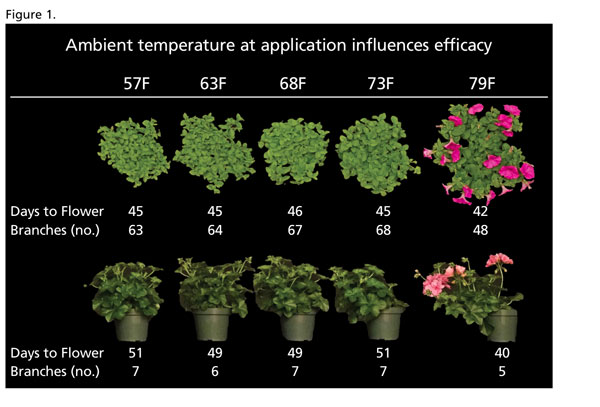7/1/2021
Florel by the Numbers
Rick Yates
Florel is a versatile plant growth regulator (PGR) best known for its ability to stimulate lateral branching in a wide range of ornamental plants. Ethephon, the active ingredient in Florel, sports an impressive list of plant responses. In addition to the remarkable branching effect, reducing internode elongation and keeping plants in, or returning them to, a vegetative state are some of the benefits. By taking advantage of these attributes, growers can save labor and reduce the risk of spreading sap-transmitted viruses by eliminating the need for hand or mechanical pinching.
Keeping plants in a vegetative state until blooms are needed for sale directs more of the plant’s energy into developing the architecture of the plant. At the same time, this reduces the risk of Botrytis posed by premature flower petals dropping from hanging baskets onto crops below. Furthermore, by reducing or eliminating pollen from premature blooms, the thrips reproductive capacity is significantly impaired through restricting their food supply. Chalk up another benefit to the flower-scheduling ability of Florel!
Despite the long list of benefits from Florel applications, some growers struggle with inconsistent or inferior results from their applications. At times, expected results weren’t realized, and at other times, unexpected crop damage has occurred. In an effort to understand what’s behind the variability, researchers have looked at various aspects of mixing and applying Florel. Maximizing the effects of this plant hormone requires us to master some numbers.
• 5.0 is the mark to hit when monitoring the pH of Florel spray solutions. If the final spray solution pH is above 5.0, the full effectiveness of Florel will not be realized. Florel is acidic, but high alkalinity water sources will probably need additional acidification to hit that number. Growers using acid injection to mitigate excess alkalinity in their irrigation water may already have what they need if that treated water is used to mix Florel.
Indicate 5 is a unique product that’s added to the spray tank before adding pesticides. This drops the pH of the spray water, indicated by a color change. Mix up a small batch of Florel at the desired ppm and use a calibrated pH pen to determine if the pH has been corrected to the proper range.
• 500 ppm is the most common rate used for Florel applications, but it’s not always the ideal rate. Trial a range of rates on crops that you haven’t previously treated with Florel to zero in on the correct rate. Mandevilla, purslane and Calliope Geraniums are examples of crops that can be adversely affected by 500 ppm Florel applications.
 Research by Jim Faust of Clemson University showed higher rates, 750 to 1,000 ppm, were required to return garden mums to a vegetative state when exposed to persistent cool nights and subsequent premature budding. As Florel is a stress enhancer, even applying the correct rates to plants under stress may lead to crop damage.
Research by Jim Faust of Clemson University showed higher rates, 750 to 1,000 ppm, were required to return garden mums to a vegetative state when exposed to persistent cool nights and subsequent premature budding. As Florel is a stress enhancer, even applying the correct rates to plants under stress may lead to crop damage.
• 73F (22C) appears to be the maximum temperature to apply Florel and achieve the expected results. Roberto Lopez of Michigan State University studied and demonstrated the response of petunias and ivy geraniums to Florel at a range of temperatures. The best ways to evaluate the effectiveness of a Florel application is to measure the days to bloom and the number of branches per plant. Figure 1 shows that both crops demonstrated a consistent response to Florel from 57 to 73F (11 to 22C), but at 79F (26C), the plants no longer appear to respond to the treatment. It’s possible that the temperature at the time of application may account for much of the variability in plant responses that growers have reported.
Florel will not translocate from treated portions of the plant to untreated areas; uniform spray coverage is required for optimum results. In some cases, this may require spraying from both sides of the plant. Spray volume also is important—recommended at 1 gallon per 200 sq. ft. of coverage. Florel is a great tool for growers; following these steps will improve the uniformity and predictability of treatment results.
There are other brand names with the same active ingredient as Florel, in some cases with a different percentage of active ingredient, that are labeled appropriately for commercial horticulture. It’s the responsibility of the applicator to read and follow the entire pesticide label. GT
Rick Yates is GGSPro Technical Services Manager for Griffin.